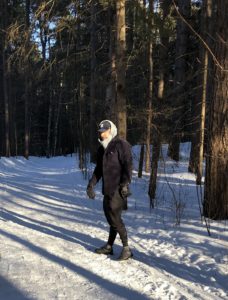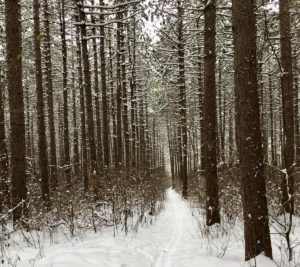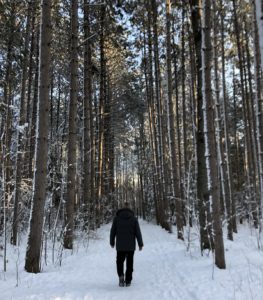As Ann Stewart will tell you, it’s the best time of year to take a hike. The active empty nester has been an outdoor enthusiast for years, so she’s also quick to admit that, in her opinion, almost any time of year is ideal to hit the trails. “Apart from days when there’s extreme cold, extreme heat, a blizzard or heavy rain, I’m good to go.”
 Preparedness is essential, though, she cautions, no matter the season or weather. “It’s a safety issue. Besides that, you don’t want to be cold or wet. It’s no fun either to be thirsty or hungry.” Especially when you’re exploring a new area or trail system, you need to be organized to ensure ease, safe going and a positive experience. That means planning, doing your research, managing your time and having appropriate attire, gear and provisions.
Preparedness is essential, though, she cautions, no matter the season or weather. “It’s a safety issue. Besides that, you don’t want to be cold or wet. It’s no fun either to be thirsty or hungry.” Especially when you’re exploring a new area or trail system, you need to be organized to ensure ease, safe going and a positive experience. That means planning, doing your research, managing your time and having appropriate attire, gear and provisions.
In winter, the weather can change quickly and drastically, so it’s best to anticipate that potential. You also want to respect the time of day to ensure you don’t get stuck on an unfamiliar trail when the sun is going down in late afternoon. At the same time, one of the advantages of hiking at this time of year is the weather. Once the temperature drops below 4C, there’s less worry about ticks and more freedom to tackle any bush trails that strike your fancy and suit your fitness level.
Mosquitoes? Blackflies? Horseflies? They’re not an issue. Even the garter snakes are hibernating. However, it is possible to cross paths with wildlife in winter. While it’s fascinating to spot a deer or fox in the distance or an owl or porcupine in a tree, it’s important to not startle, feed or turn your back on an animal in the bush. Keep your distance and, more importantly, learn how to safely respond. Do you know what to do if you encounter a bear? A coyote? Find out here: ontario.ca/page/prevent-bear-encounters-bear-wise and here: ontario.ca/page/preventing-and-managing-conflicts-coyotes#encounter.
Generally, these animals steer clear of people. You can also do your part to avoid them by staying on the trail, leashing your dog, not wearing earbuds and being mindful of signs such as fresh droppings or tracks.
 Happy Trails
Happy Trails
There are innumerable paths and trail systems to explore in this part of Ontario and Quebec. From the Mill of Kintail Conservation Area trails in Mississippi Mills and the Eagles Nest Lookout and Manitou Mountain trails in Calabogie to the trails at Gould Lake Conservation Area and at Presqu’ile Provincial Park, options are plentiful for every skill and energy level. The Ontario Trails Council at ontariotrails.on.ca lists 55 different trails just in the Ottawa and countryside region. Spend some time at ncc-ccn.gc.ca/places-to-visit to discover all the hiking destinations in Ottawa’s Greenbelt and at Gatineau Park. You’ll find more inspiration via healthyhikes.ca, ontariotrails.on.ca, rideautrail.org and tctrail.ca.
There are also opportunities to join hiking clubs. Check out ottawaoutdoorclub.ca, ottawaramblingclub.org and rideautrail.org. The City of Ottawa offers the Active Living Club for people aged 50-plus, with cycling and hiking in spring through fall and cross-country skiing and snowshoeing in winter. What’s more, Hike Ontario, hikeontario.com, offers Safe Hiker classes for beginners and Certified Hike Leader training for experienced hikers.
For starters, though, you might want to try a few easy trails close to home. And before you head out, lay the groundwork for a great hike:
 The Basics
The Basics
-Share your plans with a family member, neighbour or friend, so your location and return time are known.
-Check the length of the trail and the level of difficulty. Leave yourself extra time so you’re back at the parking lot while there’s still plenty of light.
-Be sure your smartphone is fully charged. Take along a trail map and a compass, particularly if you’re new to the route.
-Stay on the trail. (It’s possible to get lost, even in familiar territory where you’ve hiked before, because the landscape looks different depending on the season.)
-Dress in layers, with water- and windproof outerwear. Don’t forget your hat and gloves/mitts. A balaclava and hand and foot warmers are always handy to have in your backpack or jacket pockets.
-Choose footwear, preferably waterproof hiking boots or shoes, that provides traction, ankle support, comfort, insulation, dryness and ease in walking. (Boots or shoes also shouldn’t be too heavy.)
-Carry water and snacks such as nuts, energy bars, trail mix, granola, beef jerky, fruit or a peanut butter and banana sandwich. Sunscreen, lip balm, a whistle, bear spray and matches are also recommended.
-If you’re hiking with your dog, be sure your companion is on a leash. That keeps both of you safe.
-Leave the trail as you found it. Take your garbage with you to dispose of at home.
-Don’t go on or near ice.
-Don’t walk on ski tracks.
-Stop periodically to rest and enjoy the view.






